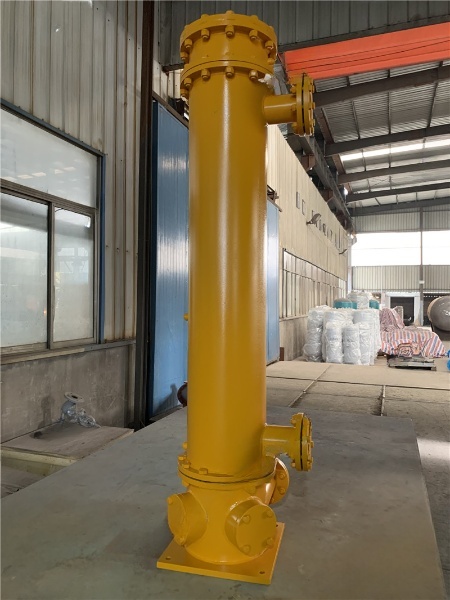Plate-Type Oil Cooler
A plate-type oil cooler is a compact, high-efficiency heat exchanger that cools oil (hydraulic, lubricating, or industrial oil) using water or coolant. It consists of multiple thin, corrugated metal plates stacked together, providing a large surface area for heat transfer.
Working Principle
- Hot Oil Inlet → Oil flows through alternate channels between plates.
- Coolant (Water/Glycol) Inlet → Cooling fluid flows in counter-current or parallel direction.
- Heat Exchange → Heat transfers from oil to coolant through stainless steel/ titanium plates.
- Cooled Oil Outlet → Oil exits at a lower temperature.
- Warmed Coolant Outlet → Heated coolant is recirculated or discharged.
Key Components
| Component | Function |
| Heat Plates | Thin, corrugated metal sheets (stainless steel, titanium) for heat transfer. |
| Gaskets (for gasketed type) | Seal plates & direct fluid flow (NBR, EPDM, or Viton). |
| Frame & Pressure Plate | Holds plates tightly together. |
| Inlet/Outlet Ports | Entry & exit points for oil and coolant. |
| Support Bar & Guide Rail | Ensures proper plate alignment. |
Types of Plate-Type Oil Coolers
1. Gasketed Plate Cooler
- Uses replaceable rubber gaskets to seal plates.
- Pros: Easy to disassemble & clean, expandable (add/remove plates).
- Cons: Gaskets degrade over time (maintenance needed).
- Applications: Hydraulic systems, industrial machinery.
2. Brazed Plate Cooler
- Plates are permanently brazed together (copper or nickel).
- Pros: No gaskets, compact, handles high pressure/temperature.
- Cons: Non-serviceable (if clogged, must replace entire unit).
- Applications: Refrigeration, compressors, small engines.
3. Welded Plate Cooler
- Plates are laser-welded (no gaskets).
- Pros: Handles aggressive fluids, high temps/pressures.
- Cons: Expensive, not cleanable.
- Applications: Chemical processing, high-pressure hydraulics.
4. Semi-Welded Plate Cooler
One fluid path is gasketed, the other is welded
- Pros: Balances serviceability & durability.
- Cons: More complex than fully gasketed.
- Applications: Oil cooling with corrosive coolants.
Advantages & Disadvantages
◉ Advantages
◉ High efficiency (3-5x better than shell & tube).
◉ Compact & lightweight (saves space).
◉ Easy to expand capacity (add more plates).
◉ Lower oil volume (reduces system lag).
◉ Works well with low-viscosity oils.
◉ Disadvantages
◉ Not ideal for high-viscosity oils (can clog).
◉ Gasketed models need maintenance (gasket replacement).
◉ Lower max pressure than shell & tube (typically ≤ 300 psi).
Applications
- Automotive & transmissions (cooling gearbox oil).
- Hydraulic systems (construction equipment, presses).
- Industrial machinery (compressors, turbines).
- Marine & aerospace (compact cooling solutions).
Maintenance Tips
- Regular Inspection – Check for leaks (gasketed models).
- Cleaning – Flush plates to remove deposits (chemical/mechanical).
- Gasket Replacement – If hardened/cracked (for gasketed types).
- Monitor Pressure Drop – Sudden increase = clogging.
Comparison with Shell & Tube Cooler
| Factor | Plate-Type Cooler | Shell & Tube Cooler |
| Efficiency | Very High | Moderate |
| Size/Weight | Compact & Light | Bulky & Heavy |
| Pressure Limit | Medium (≤ 300 psi) | Very High (≥ 500 psi) |
| Maintenance | Easy (gasketed) / Hard (brazed) | Easy (removable tubes) |
| Cost | Lower initial cost | Higher initial cost |
Selection Criteria
- Oil Viscosity → Best for low/medium-viscosity oils.
- Space Constraints → Ideal where compactness is critical.
- Pressure Needs → Choose brazed/welded for higher pressures.
- Maintenance Preference → Gasketed for serviceability, brazed for durability.
The plate-type oil cooler is the best choice for high-efficiency, space-saving cooling in automotive, hydraulic, and industrial systems. For high-pressure or high-viscosity oils, a shell & tube cooler may be better, but for most applications, plate coolers offer superior performance.
